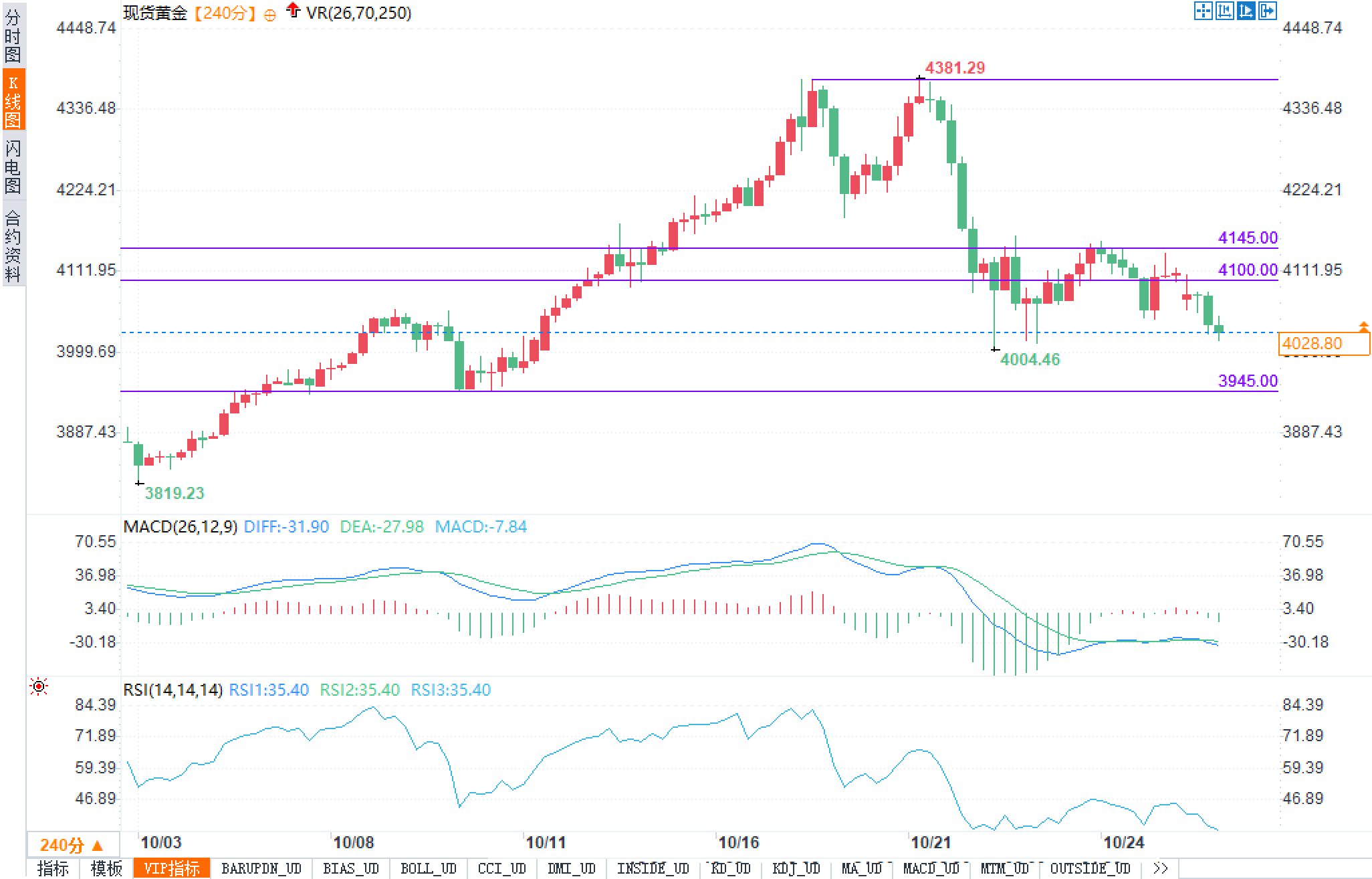Gold goes from "historical high" to "range fighting": the battle to defend $4,000, can slow-moving funds turn the tide?
2025-10-27 22:06:11

From a macro perspective, benign US inflation readings last trading week have heightened market bets on easing, with interest rate futures implying a significantly higher probability of a rate cut this week. If the Fed further emphasizes a "risk-managed" approach to easing in its statement and post-meeting guidance, a decline in real interest rates will directly improve the return comparison for gold. Conversely, if it emphasizes "data dependence and patient observation," real interest rates could stabilize or even rise slightly, amplifying gold's resilience to short-term pressure. Meanwhile, US fiscal uncertainty and the disruption to growth expectations caused by the extended government shutdown have intensified the tug-of-war between the "safe-haven premium" and yields, increasing gold's resilience to the macro narrative.
From a sentiment perspective, positive signals regarding the trade environment boosted risk assets, and the stock market continued its rebound. A recovery in risk appetite often weakens marginal demand for precious metals, providing one intuitive explanation for the recent pullback in gold prices from their highs. However, it should be noted that gold's downward support is not fragile. First, if the Federal Reserve implements marginal easing policies and its communication is dovish, the US dollar and real interest rates could fall further, further reducing the opportunity cost of holding gold. Second, geopolitical and macroeconomic uncertainties have not disappeared; they have only been temporarily suppressed. Once risk factors return, safe-haven buying is expected to resume. Third, some official and long-term investment funds are inclined to buy on dips during pullbacks. While this may not provide a single driver, it can help mitigate the downward slope.
In terms of market performance and sector linkage, gold's pullback has roughly coincided with the rise of risky assets, demonstrating a typical "risk-on/off" mechanism: when stock markets and credit spreads point to optimism, gold is primarily driven by profit-taking; when the growth and inflation outlooks implied by the yield curve diverge, gold is more influenced by real interest rates and long-term term premiums. Compared to crude oil, gold is less sensitive to supply-side disruptions, responding more to a combination of interest rate, exchange rate, and risk appetite. Compared to industrial metals, gold is more strongly driven by the "risk-off-against-risk-off" dynamic, with industrial metals being more sensitive to manufacturing activity and inventory cycles.
Technical and structural aspects
Looking at the four-hour chart, gold prices have been consolidating in the 4000-4100 range since retreating from the 4381 high. Structurally, the market is showing a weak "lower highs, lower lows" pattern of oscillation. 4100 and 4145 constitute strong resistance above. Below, 4004 marks the recent pivot, previously marked by a long lower shadow, demonstrating strong support. Below this, attention is focused on the temporary support at 3945. Regarding indicators, the MACD remains below zero, but with a shortening green bar, indicating a marginal weakening of bearish momentum. The RSI hovers around 35, indicating weakness but not extremes. Overall, the price is more likely to form a range between 3945 and 4145. We will continue to monitor whether the market can effectively recapture 4100 and whether momentum will support it before determining whether the market has shifted from weak to stable.

Gold prices have retreated over 2% from their all-time highs, and short-term indicators are entering a phase of digestion, characterized by high-level volatility and a period of time-trading. Futures curves are mostly trading in a discount or slightly flat pattern for the near-month contract, indicating that short-term volatility is driven primarily by sentiment. If policy implementation signals a directional change in real interest rates, the curve could rapidly reprice. Regarding allocation structure, on-market passive funds, having accumulated significant paper gains during the previous rally, are currently prioritizing drawdown control. In contrast, long-term allocation funds and some central bank-style buying are less sensitive to price elasticity and are more concerned with the medium-term trajectory of nominal interest rates and the inflation gap, providing "slow-variable support" for gold prices. In other words, while short-term drivers are driven by "fast variables" (risk sentiment, post-meeting guidance, and momentary yield fluctuations), the medium-term underlying logic remains determined by "slow variables" (real interest rate core, inflation stickiness, and the rebalancing of asset correlations).
Examining current gold pricing from a "cause-effect-chain" perspective: The first link is policy expectations. If the Fed cuts interest rates and signals stronger forward-looking easing, gold will benefit from falling real interest rates and lower holding costs. If the Fed adopts a restrained tone, emphasizing data dependence and inflation stickiness, the market may revise its expectations for the pace of easing, leading to a pullback in gold prices. The second link is the combination of growth and inflation. If growth remains resilient and inflation is subdued, real interest rates will be supported, putting pressure on gold. If both growth and inflation are revised downward simultaneously, risk aversion and easing expectations will converge, supporting gold. The third link is cross-asset flows. Increased volatility in stocks, bonds, and currencies often drives portfolio rebalancing, causing gold to switch roles between a "hedge asset" and a "beneficiary of liquidity."
Looking ahead to this week
Scenario A: If the Federal Reserve reinforces its "easing bias" in its statement and press conference, while the ECB and Bank of Canada's communications also favor stabilizing growth and controlling risks, the US dollar and global real interest rates could decline, potentially stabilizing gold and attempting to reestablish its upward momentum. Scenario B: If post-meeting rhetoric emphasizes that a decline in inflation remains to be verified, economic conditions warrant a wait-and-see approach, and the market moderately postpones expectations for rate cuts, nominal and real yields could rebound, leading to a continued volatile pullback in gold. Scenario C: If fiscal uncertainty or external geopolitical factors intensify again, leading to a rise in risk aversion, gold could quickly gain support on the basis of sentiment. These three scenarios are not mutually exclusive and could unfold one after another within a week. The key lies in the sequencing of policy communications and data releases, as well as the market's "interpretation preferences."
- Risk Warning and Disclaimer
- The market involves risk, and trading may not be suitable for all investors. This article is for reference only and does not constitute personal investment advice, nor does it take into account certain users’ specific investment objectives, financial situation, or other needs. Any investment decisions made based on this information are at your own risk.





















